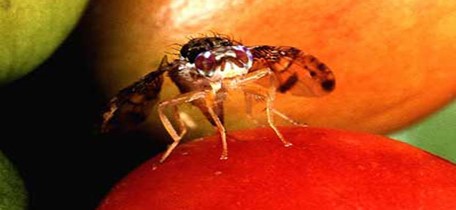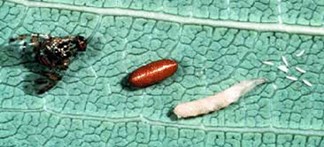CERATITIS CAPITATA – MEDITERRANEAN FRUIT FLY
CERATITIS CAPITATA “MEDITERRANEAN FRUIT FLY”
editerranean fruit fly, Ceratitis capitata , is one of the world's most destructive fruit pests. The species originated in sub-Saharan Africa since 1880’s , because of its wide distribution over the world, its ability to tolerate cooler climates better than most other species of tropical fruit flies, and its wide range of hosts, it is ranked first among economically important fruit fly species. Its larvae feed and develop on many deciduous, subtropical, and tropical fruits and some vegetables. Although it may be a major pest of citrus, often it is a more serious pest of some deciduous fruits, such as Guava , peach, pear, apricots , Mango , grapes and apple.


In this age of jet transportation, the "medfly" can be transported from one part of the world to some distant place in a matter of hours, which greatly complicates efforts to contain it within its present distribution. Once it is established, eradication efforts may be extremely difficult and expensive. In addition to reduction of crop yield, infested areas have the additional expense of control measures and costly sorting processes for both fresh and processed fruit and vegetables.
Source of the damage :
The length of time required for the medfly to complete its life cycle is 21 to 30 days. A female medfly is real source of the damage which will lay one to 10 eggs in an egg cavity 1 mm deep, may lay as many as 22 eggs per day, and may lay as many as 800 eggs during her lifetime (usually about 300). Females usually die soon after they cease to oviposit.

Females will not oviposit when temperatures drop below 16°C , except when exposed to sunlight for several hours. Development in egg, larval, and pupal stages stops at 10°C. Pupae carry the species through unfavorable conditions, such as lack of food, water, and temperature extremes.
Adults die within four days if they cannot obtain food. Usually about 50% of the flies die during the first two months after emergence. Some adults may survive up to six months or more under favorable conditions of food (fruit, honeydew, or plant sap), water, and cool temperatures. When host fruit is continuously available and weather conditions favorable for many months, successive generations will be large and continuous. Lack of fruit for three to four months reduces the population to a minimum.
Management control of Medfly:
Thresholds
Every plant tolerates certain amount of pests and damage
When should action be taken?
The thresholds is too significant component of the IPM & very fluctuating from region to region and year to year hence each year technical team of Crop IQ with the collaboration with its local partners working scientifically to determine the threshold annually & regionally .
Maintains of monitoring traps at boards of the plot one of the most effective economic tools for Monitoring Medfly
IPM of Ceratitis Capitata:
SIX control methods to control Medfly
PREVENTATIVE MEASURES :
Early detection is vital to prevent establishment of populations. Detection programs using pheromones and attractants and constant monitoring are required to ensure early detection . (Countries which export fruit have to make sure that a comprehensive detection program is maintained and that strict quarantine procedures are in place to prevent the spread of the pest to fly-free zones. Control options should be started early to hinders mating of the females with the males .
CHEMICAL :
The two control methods which are most recommended and most widely used are foliage baiting and cover spraying of Pesticides (Delatamethrin , Lambada Cyhalothrin & Pyrothriods group).
Depending on the level of infestation, the two methods can be used together to increase the level of control.
FOLIAGE BAITING :
The female medfly requires a source of protein for the maturation of her eggs which she acquires naturally from sources such as: fruit juices, bacteria, bird droppings. The foliage bait combines a source of protein with an insecticide and is attractive for both the male as well as the female medfly. The bait is usually applied in the morning hours and applied as a spot application aimed at the middle of the trees.
COVER SPRAYING :
Cover spraying controls all life stages through contact and penetrative action, however “any other insects present at the time of spraying will be killed”). Spraying is normally carried out when fruits are half or two thirds in size.
3. Mass Trapping of Medfly :
Distribute IQ CERA traps in field, with rate 1-2 unit/hectare for monitoring purpose and 30-40 unit/hectare for mass trapping.
4. PHYSICAL Control :
Fruit can be bagged to prevent egg being laid within fruit. Minimizing the amount of ripe fruit on trees at any one time, by regular harvesting & then buried/burn , can help suppress large populations of medfly
from developing
5. Biological Control :
The most important parasites introduced for biological control of Medfly are the braconid wasps. Two of these which are host-specific to Medfly are Opius humilis and Diachasma tryoni In recent times, the biological control efforts have focused on the augmentative releases of the braconid wasp Diachasmimorpha longicaudatus and other Opiinae braconids .
In terms of future biological control agents for Medfly, Hymenopterous parasitoids are thought to have the most potential for the future biological control of Medfly . Although biological control of Medfly can be effective in reducing population size, it does not lead to eradication unless combined with another control technique in an integrated management strategy. Funding for research into biological control agents for Medfly has been sparse compared to other control methods such as baiting and other chemical control methods .
6. STERILE INSECT TECHNIQUE (SIT) – OR RELEASE INSECT ADOMINATE LEATHL
A technique called the sterile insect technique (SIT) is used to contain and exclude populations of medfly. The goal of SIT is to release sterile males to mate with any introduced wild females, resulting in the production of infertile eggs. SIT has been shown to be a successful technology method of suppressing or eradicating fruit fly populations on an area wide scale in different parts of the world
How to control CERATITIS CAPITATA ?
Related products and innovations:
Attract and kill solution:
1. IQ CERA-GEL (environmentally friendly new attract and kill gel solution specifically for Ceratitis capitata).
2. IQ FLY-HP GEL (environmentally friendly new attract and kill gel solution for most species of fruit fly).
Monitoring solution:
IQ Ceratitis 500 (Sexual pheromone trap for capture males of Medfly).
Mass trapping solution:
IQ CERASENSE-F (New unique attractant for control Medfly)
For more info, send e-mail to info@cropiq.co.uk
Or contact our consultant Dr.IQ at dr.iq@cropiq.co.uk